Introduction
‘Why would the federal government build a separate and fully functional crime laboratory just for wildlife law enforcement?’ This is the question most often asked when people hear about the National Fish and Wildlife Forensics Laboratory – the first full-service national or international crime laboratory devoted to wildlife law enforcement – located in Ashland, Oregon. The answer, sad to say, is human greed, coupled with the increasing value placed on wildlife parts and products derived from protected, threatened and endangered species. ‘But how much can a poached deer be worth?’ these questioners often respond, thinking, as most people do, that wildlife law enforcement mostly involves individual hunters violating local hunting season rules and regulations. Which is to say, mostly misdemeanor violations.
Well, in a comparative sense, a single doe taken out of season probably isn’t worth all that much. But most deer species are relatively plentiful at the moment, whereas the world is rapidly running out of elephants, tigers, leopards, jaguars, bears, and literally hundreds of other species. Which is why you can find elephant leather briefcases and elephant ivory carvings on sale for several hundred dollars apiece; tiger claw necklaces and leopard/jaguar coats in the $5000-10 000 range; and ‘canned’ hunts for grizzly bears starting at $15 000. And the list goes on in a progressively depressing manner.
But all of this should not come as much of a surprise. After all, to a great extent, it is just human nature. People want to buy things that are rare and/ or unusual . . . either to possess themselves or to give as special gifts. And what could be more rare or usual than a shatoosh shawl made from the microscopically fine hairs of the fleece of the Tibetan antelope (Pantholops hodgsonii), or a fine long-stemmed comb made from the shell of a 40-year-old Ridley sea turtle, or a 1 oz (30 g) tin of caviar from the endangered short nose sturgeon?
And then we get into cultural issues, and discover that many of these wildlife parts and products are considered critical ingredients of a wide array of traditional Asian medicines that have been used for thousands of years, which results in hoarded rhino horns selling for $75 000 each, bear gall bladders for a $1000 a gram, and tiger bones for whatever the market will bear – which is quite a lot these days.
And we cannot forget the underlying philosophical question: whether or not species should simply be allowed to go extinct through the process of ‘natural’ selection, whatever that may or may not mean.
But, in essence, the wildlife problem really comes down to the simple issue of supply and demand on a national and international scale. Much like the illicit drug trade, if there is a demand for an illicit wildlife part or product, and a great deal of money to be had, then enterprising criminals will find a way to supply the goods. And you can be sure these suppliers will not be overly concerned about national or international borders, much less the possibility that these endangered and threatened species may well disappear before the next generation of suppliers can seek their illicit profits.
Thus the mission of the National Fish and Wildlife Forensics Laboratory: to provide forensic support for game wardens, conservation officers and wildlife special agents throughout the world. And, in doing so, we often find ourselves involved in felony investigations as well as misdemeanors, because it is a felony to violate the US Endangered Species Act, the penalty for which may be as much as a $100 000 and a year in federal prison per count. And all of a sudden, trafficking in wildlife parts and products becomes serious business for all concerned.
So how does a national and international wildlife crime laboratory go about its assigned mission to provide forensic support to state, national or international wildlife law enforcement officers? Well, the answer to that question is a bit complex. And as you will soon see, it takes us right back into thorny issues of philosophy and culture as well as science.
But first, let us start at the beginning.
Basic elements of wildlife forensic science
As in any police crime laboratory, forensic experts employed by a wildlife crime laboratory are expected to do two things:
1. identify their evidence;
2. in a triangular fashion, link suspect, victim and crime scene together with that physical evidence.
The only significant difference is that, in a wildlife investigation, the victim is almost always an animal, and every now and then it turns out that the suspect is also an animal. Thus, the first obligation of a wildlife forensic scientist is to distinguish the act of one animal fighting and killing another (typically for food, territory or mates) from acts of human greed and avarice against animals. It is only then that wildlife forensic scientists can begin to apply the principles and techniques of forensic science to the investigation of wildlife crimes – the point at which the problems truly begin.
In the following paragraphs, we hope to provide the reader with an understanding of these problems, a history of wildlife forensics, and an overview of the forensic principles and techniques currently being applied to wildlife-related evidence, as well as a sense of how we think wildlife forensics might evolve in the coming years.
Problems of Wildlife Forensics
At a homicide scene, the task of linking the suspect to the victim and the crime scene is often complicated by the difficulty of determining what the scene was like before the suspect and victim came into lethal contact. In a like manner, the difficulty of linking the suspect and victim in an illegal hunting situation is frequently complicated by:
• the circumstances under which an animal can be legally killed;
• the lack of species-specific definitions for wildlife parts and products.
Legal versus illegal kills
In a sense, human forensic scientists have it easy because it is almost always illegal to kill a human being (except in self-defense or in an act of war). However, the circumstances under which an animal can be legally hunted and killed are often quite complex. Examples of this complexity can be found in the following questions frequently posed to a crime laboratory by wildlife investigators:
• How was this animal hunted and killed? Legal hunting may be restricted to the use of specific types of weapons (archery, black-powder firearms, etc.) to kill certain animals during a defined hunting season, or within a defined hunting area.
• When did this animal die? It is illegal to kill migratory birds before sunrise or after sunset during a defined hunting season, or illegal to kill most animals the day before a defined hunting season.
• Where was this animal killed? It may be legal to hunt in a federally protected wildlife refuge during a certain hunting season, but illegal to do so in adjoining private property.
• How many animals were killed by this hunter during this hunting season? It may be legal to kill one animal of a specific species during a defined hunting season, but not more than one.
• What are the genders of the animals killed? It may be legal to kill a male whitetail deer during a defined hunting season, but not a female.
• Which hunters were involved in the illegal hunting? In a typical waterfowl hunting blind situation, where several hunters may be shooting in the same area, and ‘dropped’ ducks tend to be comingled, it may be difficult to tell which hunters killed ‘over their limit’ and which hunters hit nothing at all. The issue can be further complicated if not-to-be- exceeded point values are assigned to certain species of ducks during a hunting day. • Was the animal killed in self-defense? It may be legal for a hunter to kill an otherwise completely protected endangered species in self-defense: if, for example, the bullet trajectory indicates that animal was charging the hunter instead of running away at the time of the shooting.
Lack of species-specific definitions for wildlife parts and products
In a police crime laboratory, the task of identifying evidence tends to be relatively simple. ‘The white powder is 86% cocaine hydrochloride.’ ‘The blood sample contains 0.20% ethyl alcohol.’ ‘The lethal projectile is a .40 caliber copper-jacketed hollow-point bullet.’ In these examples, the task is simple because there are simple and straightforward definitions for these items that are accepted worldwide.
But in a wildlife crime laboratory, the submitted evidence items are usually parts and products from endangered, threatened or protected species of animals. And while underlying definitions for all of these species do exist in the form of morphological or genetic ‘keys’, the definitions are almost always based upon knowing the country of origin (especially for subspecies) and having the entire animal available for examination. And therein lies the problem. Wildlife investigators rarely seize whole animals as evidence. Instead, they tend to seize parts and products of animals from boats, planes and warehouses. As such, they rarely know the country of origin of these items, and cannot depend on those who do know (usually, the suspects) to provide a dependable answer.
Given this inability to use standard taxonomic keys to determine species of origin, wildlife forensic scientists must conduct extensive research to come up with new species-defining characteristics that will enable them to stand up in a court of law and testify that a part or product in question came from a certain species, and no other species in the world. And it is the ‘no other species in the world’ part that makes the species-source identification of a wildlife part or product a formidable task indeed, especially when faced with over 4629 species of mammals, 9682 species of birds and 7962 species of reptiles.
Brief History of Wildlife Forensics
Early species identification for forensic purposes relied on visual comparisons, and microscopic ‘analysis’ of blood components. The advent of immu-nological techniques allowed an analyst to determine the Family origin of tissues; and, in a like manner, electrophoretic analysis of proteins enabled the analyst to accurately determine species origin. But it was not until the development of restriction fragment length polymorphism (RFLP) and polymerase chain reaction (PCR) techniques, and the analysis of the mitochondrial DNA sequence, that wildlife forensic scientists were able to address subspecies issues, and to compare blood or tissue samples as having come from a single common animal source.
All of this began with the first combined wildlife management and wildlife forensic laboratory established by the State of Wyoming in 1965. Other small and combined wildlife management and forensic state laboratories were created during the next two decades, but it was not until 23 years later that a full-service national wildlife forensic laboratory was created that focused only on forensic issues and did not address any other wildlife conservation issues. In 1988, the National Fish and Wildlife Forensics Laboratory was established for the unique purpose of assisting federal, state and international law enforcement officers in their investigations of wildlife law violations.
Current Science of Wildlife Forensics
While the science of wildlife forensics is still very much in its infancy, numerous protocols have been established for the identification and comparison of wildlife-related evidence. These protocols are typically divided into the following analytical categories:
• pathology;
• molecular biology;
• morphology;
• criminalistics;
• chemistry.
Pathology
Pathology is basically the study of death (Figs 1 and 2). And in a wildlife crime laboratory, veterinary pathologists are responsible for determining the cause of death of an animal. They are able to accomplish this by conducting a necropsy (autopsy) that involves a search, not only for lethal wounds caused by bullets, arrows, spears and traps but also a comprehensive toxicological examination of blood, urine, tissue and stomach/crop contents to eliminate or confirm a poison or contaminate cause of death. In doing so, the pathologist also makes a corresponding search for signs of disease vectors that may indicate a natural cause of death.
Issues that may complicate determination of cause of death in an animal, but certainly do not affect the results of a careful and professional necropsy examination, include:

Figure 1 Dr Richard Stroud and Elaine Plaisance examine a North American bear cub to determine cause of death.
• the possibility that the animal may have been struck by additional bullets, pellets or other projectiles (that were not lethal or crippling) for a period of months or years;
• the relatively common practice of illicit bow-hunters shooting at an animal with a firearm first (because it is difficult to get close enough to a suspicious animal for a killing show with a bow), and then sticking an arrow into the bullet wound;
• the possibility that the animal was killed or fatally weakened by a modern pesticide or poison that was purposefully designed to decompose rapidly after a few hours of exposure to air or sunlight;
• the likelihood that scavengers will rapidly destroy useful blood, tissue or bone evidence if the carcass is not found and collected in a matter or hours or a very few days.
In conducting necropsies involving bullet wounds, it is often extremely important that the veterinary pathologist determine the trajectory of the bullet into or through the body. This information may resolve the question of whether the accused hunter was properly defending himself or herself against a charging animal, or illegally hunting a protected species.
Molecular biology
Molecular biology is, among other things, the study of genetic information encoded in the DNA molecule and the expression of that coding into proteins and related biological structures (Fig. 3). Given the wide variety of biological structures present in the animal kingdom, molecular biology offers the wildlife forensic scientist an extremely powerful tool to:
• determine family, genus and species;
• determine gender;
• individualize blood and tissue samples.
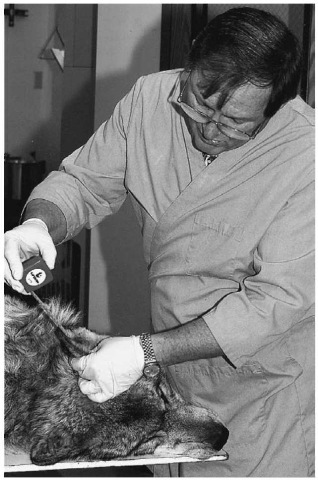
Figure 2 Dr Richard Stroud conducts a necropsy on a North American wolf.
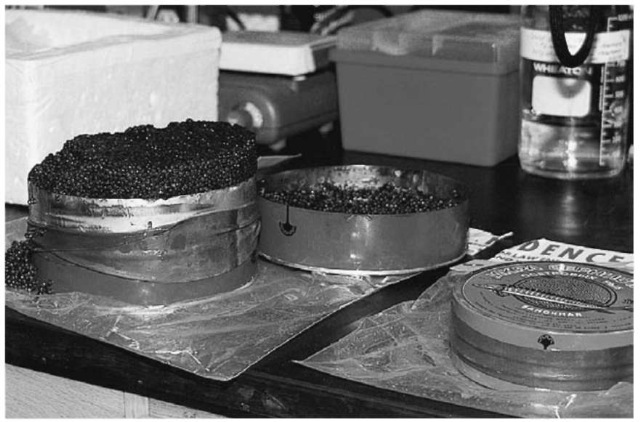
Figure 3 Caviar, the oocytes of sturgeon, is analyzed to determine species of origin. Analysis is done by sequencing part of the mitochondrial DNA of a single egg and each sequence is compared against reference standards worldwide of sturgeon species.
Family/genus/species identification The process of determining the species origin of an unknown tissue normally begins with a series of immunological tests designed to narrow the possibilities down to the species comprising a single family (e.g. bears -Family Ursidae, or deer – Family Cervidae). At that point, the examiners can go forward with either protein or DNA/PCR analysis (along with related comprehensive databases) to determine the actual species involved.
Gender identification There are a number of nuclear DNA-based gender-determining tests available for mammalian species. They generally use PCR amplification to detect specific sequences of the ZFY and/or SRY genes, both of which are located on the mammalian Y chromosome.
Individualization of blood and tissue Initial work on individualizing animal blood and tissue samples involved multilocus DNA probe hybridization techniques. However, new PCR methods for detecting single-locus single tandem repeat (STR) markers have been developed and applied in human forensic casework, demonstrating the technical feasibility of similar applications to animal species. Several wildlife forensic laboratories are currently developing STR markers for determining the individual origins of wildlife evidence tissues.
Morphology
Morphology is the study of structure. In wildlife forensic science, morphological examinations of submitted evidence items are typically conducted by eye or with the use of simple, compound or scanning electron microscopes. They are often the simplest examinations performed in a wildlife crime laboratory; but at the same time, they represent some of the most complex and difficult identification problems (Figs 4-7).
As an example, the authors of this article are both absolutely convinced that they could positively identify their daughters from 10 000 similar young women. But could they create a written protocol that would enable another forensic scientist to make that same positive identification with the same degree of certainty? Very likely not. And the reasons why such a protocol would be a difficult to write lie in the heart of the morphological problem: the lack of standard definitions.
Let us go back to that cocaine hydrochloride molecule for a moment. An underlying tenant of organic chemistry is the simple fact that one cocaine hydrochloride molecule looks exactly like every other cocaine hydrochloride molecule in the world. So, in a relative sense, it is easy for crime laboratories throughout the world to come up with a single protocol to identify cocaine hydrochloride. But what happens when a crime laboratory shifts its focus to whitetail deer?
First of all, you discover - outward appearances aside – that whitetail deer are not alike. In fact, no two whitetail deer are exactly alike (even if they are genetic twins!) because the normal wear and tear that a young whitetail deer experiences, literally from the moment of birth, create individual characteristics (a healed cut, a chipped hoof, a broken antler) that invariably show up in the animal’s morphology.
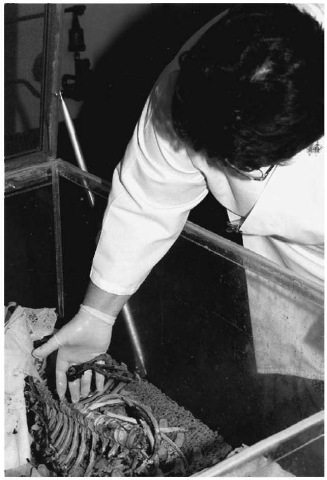
Figure 4 Bonnie Yates examines the remains of a wolf carcass that has been cleaned in the laboratory by dermestid beetles. These beetles are an essential part of cleaning mineralized tissue so that the species-defining osteological components are clearly visible.
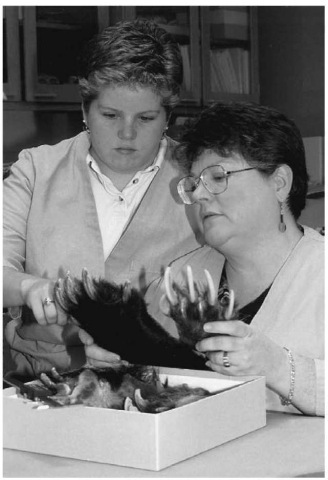
Figure 5 Bonnie Yates and Cookie Sims examine an evidence item against a bear paw morphological standard. Bear paws are found in trade for the use of the claws in jewelry and in certain Asian medicinal preparations.
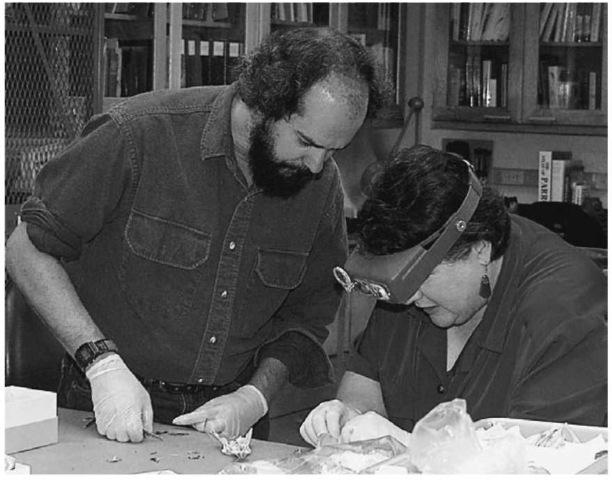
Figure 6 Dr Pepper Trail and Bonnie Yates examine osteological remains of endangered and protected birds recovered from a crime scene.
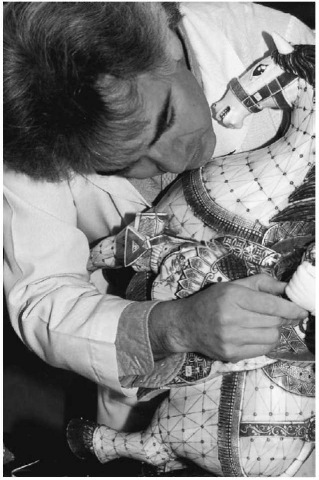
Figure 7 Dr Edgard Espinoza examines an ivory statue. Trade in ivory from African and Asian elephants is prohibited, whereas trade in the ivory from the extinct mammoth is legal.
So the immediate problem for a wildlife forensic scientist is to come up with class characteristics that distinguish and identify family, genus and species of animals that are separate and distinct from population and individual characteristics.
These identification characteristics typically fall within one of the following morphological categories:
• hair and fur;
• leather and hides;
• bones and skulls;
• teeth, claws and beaks;
• hooves, horns and antlers;
• feathers and down;
• other miscellaneous parts.
Criminalistics
The ability of a wildlife forensic scientist to process evidence from an illegal hunt, much like that of a homicide scene, often comes as an unpleasant surprise to the unwary poacher. In fact, the events associated with a typical illegal hunt often involve the following categories of ‘criminalistics’ (or police forensic science) evidence:
• trace evidence;
• firearms;
• other weapons;
• impression marks;
• latent prints;
• questioned documents.
Trace evidence Trace evidence in an animal case can involve a wide range of materials. A classic example is a case in which a mountain lion was held captive for a period of time and then killed in an illegal ‘canned’ hunt. As it turned out, the mountain lion tried to chew his way loose from the synthetic fiber ropes (two types were used by the suspects to secure the lion), and a forensic scientist was able to link the fibers from the lion’s stomach back to chewed ropes found at the crime scene.
Firearms The typical circumstances in which an animal is killed with a firearm vary greatly from those of a homicide case. The most significant differences include:
• the distance from suspect to victim;
• the choice of firearm;
• the ability of the suspect to ‘clean up’ the scene;
• the tendency of the suspect to take the victim from the scene;
• the tendency of the suspect frequently to reuse the same firearm.
Unlike human crime situations, in which the victim is most commonly killed with a pistol at short - ‘contact’ to 25 yard (23 m) – distances, the typical animal kill involves a high-powered (and large-caliber) rifle or a shotgun at relatively long distances (50-300 yards (45-275 m)).
Given the nature of the typical hunting area (brush, trees and ground cover), it is often difficult for an illicit hunter to retrieve expended casings; however, the long shooting distances and the fact that the shot could have come from any 360° vector point makes it extremely difficult for a crime scene investigator to locate the shooting point, much less the expended casings. But all of these advantages (to the illicit hunter) tend to be negated by two simple facts:
1. The whole point of the illicit hunting is for the suspect to take the victim (as a trophy or meat) back to his or her residence. Thus, the bullet is likely to either be in the carcass of the animal, or in the ‘gut pile’ left at the scene (which can be matched to the trophy head or meat with DNA techniques).
2. The typical illicit hunter spends a lot of money on a rifle or shotgun, and is rarely willing to discard the weapon after a single illicit kill. Thus, it is very likely that a succession of illegal kills can be linked to a single poacher by matching the spent bullets or casings to the rifle or shotgun.
Other ‘weapons’ Other hunting weapons typically associated with an illicit animal kill include:
• long bows and arrows;
• crossbows and ‘bolts’;
• spears;
• spring traps;
• poison discharge devices;
• nets.
Impression marks The fact that most illicit hunting situations occur in remote areas or ‘off road’ situations makes it extremely likely that the suspect will leave tire tracks and boot impressions in soil, mud or snow. And the fact that these tires and boots are typically used in off-road situations makes it all the more likely that the tire or boot treads will possess individualistic wear marks.
Latent fingerprints Latent fingerprints are the classical means of linking suspected, victim and crime scene through physical evidence (Fig. 8). The following types of latent-bearing evidence are frequently submitted to a crime laboratory in wildlife cases:
• firearms;
• expended casings (shotgun and rifle);
• knives;
• ‘No Trespassing’ and ‘No Hunting’ signs;
• game tags;
• import/export (CITES) permits.
Questioned documents A frequently-asked question in a national or international wildlife investigation is whether or not the paperwork (typically import/ export documents) is valid. This can be an extremely difficult question to answer when the authorizing seals vary between countries, the names of individuals authorized to approve import/export documents change on a frequent basis, and the shipments must be ‘cleared’ (the documents examined and approved) at the local port of entry.
Questioned documents typically associated with a wildlife case include:
• forged or altered hunting licenses;
• forged or altered game tags;
• forged or altered import/export permits.
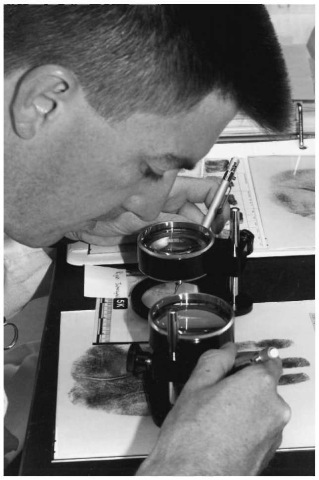
Figure 8 Andy Reinholz compares friction ridge evidence lifted from a container found at the crime scene against standard prints collected from a suspect.
Chemistry
Chemical analysis techniques are most often used in a wildlife crime laboratory to provide toxicological information to a veterinary pathologist. A forensic scientist assigned to this section of the laboratory therefore spends a great deal of time examining blood, urine, tissue and stomach/crop contents in a search for pesticides and poisons. However, analytical chemistry procedures (that utilize chemical bio-markers) are also used to identify the species source of animal products, such as bear bile and deer musk, and standard toxicological methods are routinely employed to identify chemical baits and poisons used to trap and kill wildlife (Figs 9 and 10).
Future of Wildlife Forensics
Where is all of this taking us? Into some fascinating areas of technology, no doubt, where rapid DNA sequencing techniques may enable us to crack the genetic code that distinguishes family, genus, species and subspecies. And very likely into an era where game wardens and conservation officers routinely collect blood and tissue samples from the sites of illegal kills, knowing full well that the resulting genetic data will be placed in the databases of wildlife forensic laboratories – awaiting the submission of matching evidence. Thus, poaching scenes will be routinely worked in the manner of a modern homicide investigation involving a human victim.
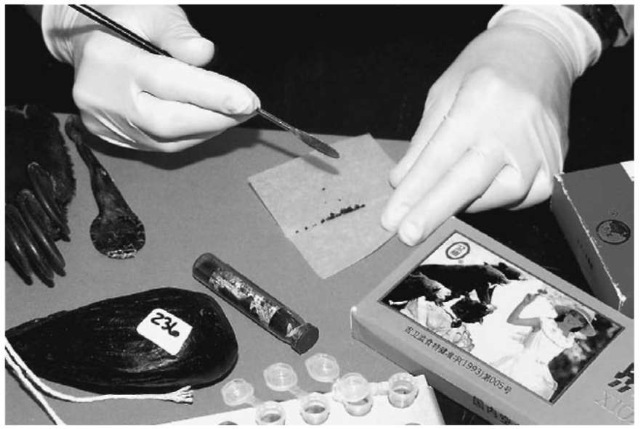
Figure 9 An examiner prepares the bile salts from an importer’s seized medicinal products to determine if the samples are of ursid provenance. The bile acids extracted from a bear’s gallbladder are used in some traditional Asian medicinal preparations.
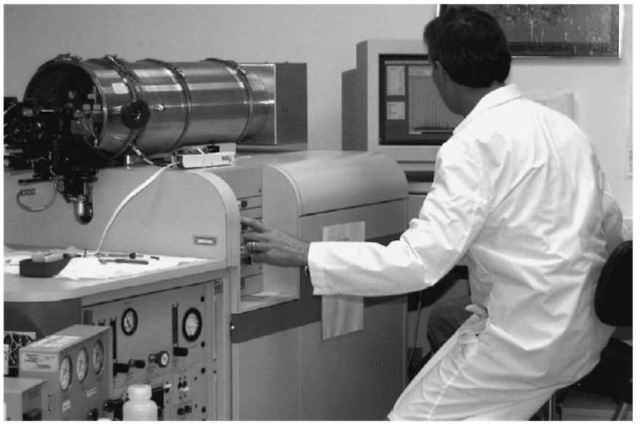
Figure 10 Dr Mark Kirms examines blood stains by electrospray mass spectrometry to determine species identities from hemoglobin molecular weights.
But regardless of where newly developed technologies take us, we will almost certainly still find ourselves facing those same thorny issues of culture and philosophy that make the practice of wildlife forensics a fascinating and thoroughly satisfying career choice.
